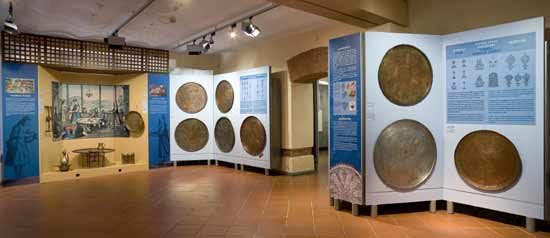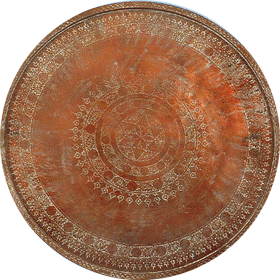Decorated Copper Trays. 2006-2007
Decorated Copper Trays, 2006-2007
The exhibition features a household item which probably dates back to Byzantine times but has remained in use to the present day: the sini, a circular tray of hammered copper, similar to a baking tray but less deep and with an outward-turning rim.
The display includes sinia from the late 17th to the 20th century, most of which belong to the Museum's own collection, the remainder having been loaned by private individuals and organizations. The exhibition also features life-size reproductions of designs from sinia, which help the visitor to appreciate their decorative value.
The sini was used as a cooking dish, as a tray on which food is offered to guests, and as a small table:
As a cooking dish the sini was plated with tin to provide protection from oxidization of the brass; it was used to bake dry food (rolls, pies) in the oven.
As a serving tray it was used for presenting food to the guests on special occasions; it also served for exchanging wedding gifts. Over the two and a half centuries leading up to the 2nd World War it was commonly given as an expensive gift by a godfather to his godchild. It came to be associated with events marking major milestones in life, and its use acquired a ceremonial character.
As a table the sini was supported on a folding base and was always decorated, or ‘embroidered' as people used to say. The ‘good sini' - a symbol of social status - was sometimes etched or inscribed. This decoration could vary in terms of technique, method and theme. Plant patterns tended to be most popular, but designs also included various utensils, religious buildings and, more rarely, human figures.
The sini presented a meeting place of two techniques in the popular tradition, copper-workand engraving; the skills involved elevated the sini from a simple household implement to an impressive and valuable artefact.
There were important centres of copper-working, in the latter period of its heyday, in Giannena, Makrinitsa, Stemnitsa, Mt. Athos, Kozani and, particularly, Thessaloniki, which had close artistic and commercial links with Constantinople.
Part of the decoration of the sini was the inscription: the name of the owner or donor, or a phrase, worked into the decorative design. It was usually incised into the rim of the sini or around its edge. On the sinia featured in this exhibition there are inscriptions in Greek, Armenian and Arabic.

Το σινί χρησιμοποιείται ως μαγειρικό σκεύος, ως δίσκος προσφοράς και ως τραπέζι:


 Follow us
Follow us 



